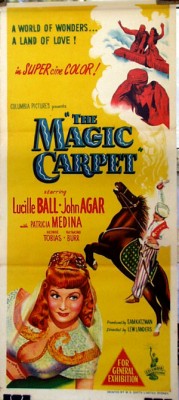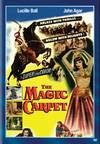| Reviews & Columns |
|
Reviews DVD TV on DVD Blu-ray 4K UHD International DVDs In Theaters Reviews by Studio Video Games Features Collector Series DVDs Easter Egg Database Interviews DVD Talk Radio Feature Articles Columns Anime Talk DVD Savant Horror DVDs The M.O.D. Squad Art House HD Talk Silent DVD
|
DVD Talk Forum |
|
|
| Resources |
|
DVD Price Search Customer Service #'s RCE Info Links |
|
Columns
|
|
|
Magic Carpet, The
Nevertheless, the film has a fine cast, decent production values, considering, and some interesting special effects. Ironically, its greatest weakness is Lucille Ball herself, who gives a disinterested, even contemptuous performance that damages the picture.
This is a "Sony Screen Classics by Request" DVD-R, its release tied to several other Ball MOD titles, and its full-frame transfer is very good given the problematic technical specs of SUPERCINECOLOR. No extras.
The film has a slam-bang opening: During a ceremony in which Caliph Omar (Leonard Penn) proclaims infant son Ramoth as his heir, an assassin hired by scheming vizier Boreg al Buzzar (Raymond Burr) fatally stabs the caliph. Boreg then chases Queen Yasmina (Doretta Johnson) to her bedchamber, where she frantically places the baby on a magic carpet. It flies off just as Boreg breaks in and murders the queen.
The carpet comes to rest in front of the small clinic of physician Ahkmid (William Fawcett), who adopts the baby and hides the magic carpet in a secret panel.
Years later, an adult Ramoth (John Agar) has followed in his adopted father's footsteps, becoming a physician himself, while moonlighting as the Scarlet Falcon, a kind of Arabian Robin Hood. This doesn't sit well with Boreg or Ali (Gregory Gay), the false caliph who usurped the throne, ruling with an iron fist and a Prince John-approach to taxation.
Ramoth plots to overthrow Ali by conspiring his way into the royal court via an appointment as his royal physician. It's here where top-billed Lucille Ball comes into the picture, in the role of Ali's femme fatale of a sister, the vain and flirtatious Narah. Elsewhere, Lida (Patricia Medina), the rebellious sister of Razi (George Tobias, who played a similar part in 1947's Sinbad the Sailor), Ramoth's right-hand man, joins the rebels and vies for Ramoth's affections.
Lucille Ball began her career at Columbia and elsewhere, then worked her way up to RKO and then MGM before working her way back down again to Columbia in 1947, beginning with Her Husband's Affairs. She was making the transition from radio's My Favorite Husband to television's I Love Lucy but still owed Columbia one last movie. Ball later claimed studio head Harry Cohn assigned her to The Magic Carpet specifically to embarrass and punish her for alleged combativeness. In her autobiography Ball stated that she was paid $85,000 for five days work - more than half the entire film's cost.
She may very well have worked on The Magic Carpet for as little as five days, she's not in it all that much (top-billing notwithstanding), but I doubt the film was made for $170,000, though it probably did come in for well under $500,000. It's actually pretty lavish by producer Sam Katzman's usual standards. There are lots of camera set-ups, money shots with dozens of costumed extras populating well-appointed backlot sets, numerous matte and miniature shots, etc.
The carpet itself is brought to life in the same manner as in the silent Thief of Bagdad. Agar himself rides the full-size prop as it takes off. (The many wires that lift it and glide it along are impressively invisible.) Sculpted dummies and clever editing take over once the full-size carpet is more than about six feet in the air, for obvious reasons. As it flies over the city, glass paintings and/or miniatures are utilized, the illusion enhanced by a multi-plane effect. (The foreground and background paintings/miniatures move past the camera at different speeds.)
The film is not without humor here and there, wisely acknowledging its basic ridiculousness. When examining a patient, for instance, Agar's doctor instructs him to "Open your mouth and say 'Ali Baba.'"
Ironically, everyone seems in on the joke except Ball. She might have been quite funny vamping it up, like Lucy Ricardo at a screen test, trying to break into show business. Instead she looks bored and is clearly putting minimum effort into the part. She gives the film's worst performance, no small feat considering that her co-star is John Agar, a likeable but usually terrible actor who at least is in there slugging.
Ball's even poor in her scenes with Raymond Burr, who's like a fat Conrad Veidt in this and quite excellent. (Before Perry Mason he often played villains. Though the movies varied widely in terms of quality - from Bride of the Gorilla to Rear Window - Burr himself was usually terrific and imposing.)
Improbably cast as George Tobias's sister, British-reared Latina Patricia Medina affects a completely convincing American accent, and gives a wonderfully boisterous, amusing performance as Lida. Considering that later on Medina often played villains (e.g., Snow White and the Three Stooges, Latitude Zero) one wonders if she and Ball should have switched parts.
Video & Audio
As mentioned above, The Magic Carpet was filmed in SUPERCINECOLOR a low-rent process that strongly favored reds and browns, which made it a good process for this kind of desert-based film (Agar's flowing red silks as The Scarlet Falcon come off particularly well). The physical properties of SUPERCINECOLOR make Technicolor-like restorations impossible but Sony has done an excellent job here, with results slightly superior to Warner Archive's generally good remastering of Abbott & Costello Meet Captain Kidd, another SUPERCINECOLOR masterpiece. There are no menu screens or options at all: the inserted disc starts and stops on its own. The region-free DVD-R disc's mono audio (English only, with no subtitle options) is acceptable. There are the usual chapter stops every ten minutes but no Extra Features at all.
Parting Thoughts
Against all expectations, The Magic Carpet proved enormous fun, despite Ball's wet-blanket performance. Within B-picture parameters it's lively and delivers loads of colorful fantasy action.
Stuart Galbraith IV's audio commentary for AnimEigo's Tora-san, a DVD boxed set, is on sale now.
|
| Popular Reviews |
| Sponsored Links |
|
|
| Sponsored Links |
|
|
| Release List | Reviews | Shop | Newsletter | Forum | DVD Giveaways | Blu-Ray | Advertise |
|
Copyright 2024 DVDTalk.com All Rights Reserved. Legal Info, Privacy Policy, Terms of Use,
Manage Preferences,
Your Privacy Choices | |||||||














